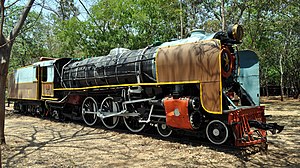Indian locomotive class YP
| Indian locomotive class YP | |||||||||||||||||||||||||||||||||||||||||||||||||||||||||
|---|---|---|---|---|---|---|---|---|---|---|---|---|---|---|---|---|---|---|---|---|---|---|---|---|---|---|---|---|---|---|---|---|---|---|---|---|---|---|---|---|---|---|---|---|---|---|---|---|---|---|---|---|---|---|---|---|---|
 No. 2511 on display at the Railway Museum, Mysore. | |||||||||||||||||||||||||||||||||||||||||||||||||||||||||
| |||||||||||||||||||||||||||||||||||||||||||||||||||||||||
| |||||||||||||||||||||||||||||||||||||||||||||||||||||||||
| |||||||||||||||||||||||||||||||||||||||||||||||||||||||||
| |||||||||||||||||||||||||||||||||||||||||||||||||||||||||
The Indian locomotive class YP are a class of 4-6-2 passenger locomotives built for Indian Railways' metre gauge network that are one of several post-partition standard designs evolved from the pre-war Indian Railway Standard designs.[1]
History
[edit]A total of 871 locomotives were built between 1949 and 1970 by various manufacturers. They were among the most commonly-used steam locomotives in the country and one of the last built specifically for passenger service in the world. Baldwin Locomotive Works delivered the first batch of 20 locomotives in 1949, followed by another 100 by the North British Locomotive Company, and Krauss-Maffei supplied a further 200 locomotives between 1952 and 1954. The remaining 551 were domestically built by Tata Engineering and Locomotive Co. between 1954 and 1970.[1][2]
Until the 1990s, YP class were in service on India's metre-gauge network in large numbers, especially, in the states of Rajasthan, Assam and Tamil Nadu.[1]
Several examples have been preserved and are now on display in various Indian railway museums. Numbers 2257 and 2684 were sold in 1990 to American-owned Railroad Development Corporation and were seen in Togo as of 2007[update].[3]
Table of builders and numbers
[edit]| Year | Quantity | Builder | Serial number | Running number |
|---|---|---|---|---|
| 1949 | 20 | Baldwin Locomotive Works | 74454–74473 | 2000–2870 (not in order) |
| 1952 | 100 | North British Locomotive Company | 27120–27219 | |
| 1952–1954 | 200 | Krauss-Maffei | 17732–17781, 17991–18140 | |
| 1954–1970 | 551 | Tata Engineering and Locomotive Co. | 51–150, 201–290, 761–830, 845–935, 956–1155 |
Design
[edit]The YP class were essentially a metre-gauge version of the broad-gauge WP class, but they lacked the distinctive bullet-nose smokebox casing seen on the latter. In addition, the YPs had the latest technical features present in a steam locomotive at the time, such as a steel firebox, combustion chambers, and large-area superheater.[4]
Since the locomotives were intended for use on routes with relatively low axle loads, they had to be as light as possible. For this reason, the side panels[clarify] and cab were made of aluminum as a weight-saving measure.[1]
Allocation
[edit]The YP class locomotives were used all over India. By the end of 1976, the locomotives were allocated to the following regional zones of Indian Railways:[5]
| Zone | Quantity |
|---|---|
| Central Railways | 9 |
| Northern Railways | 101 |
| North Eastern Railways | 235 |
| Northern Frontier Railway | 98 |
| Western Railways | 155 |
| South Central Railways | 72 |
| Southern Railways | 199 |
Two locomotives of this class had been withdrawn at the time.
References
[edit]- ^ a b c d Information sheet for the YP class. Madrid: Ediciones del Prado. 2005. p. 2.
- ^ Hughes 1977, p. 24.
- ^ "Benin Tourist Railway Project". Retrieved 2022-07-05.
- ^ "YP 4-6-2". sundar.altervista.org. Archived from the original on 3 September 2017. Retrieved 24 November 2024.
- ^ Hughes 1977, p. 96.
- Hughes, Hugh (1977). Steam Locomotives in India, Part 2 - Meter Gauge. The Continental Railway Circle. ISBN 0-9503469-3-4.
Further reading
[edit]- Brian Hollingsworth: Dampflokomotiven: Ein technisches Handbuch der bedeutendsten internationalen Personenzuglokomotiven von 1820 bis heute. Springer-Verlag, 1983, ISBN 978-3-7643-1530-6, YP class on p.192



